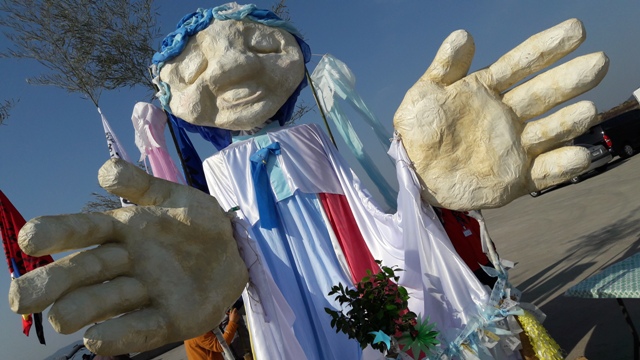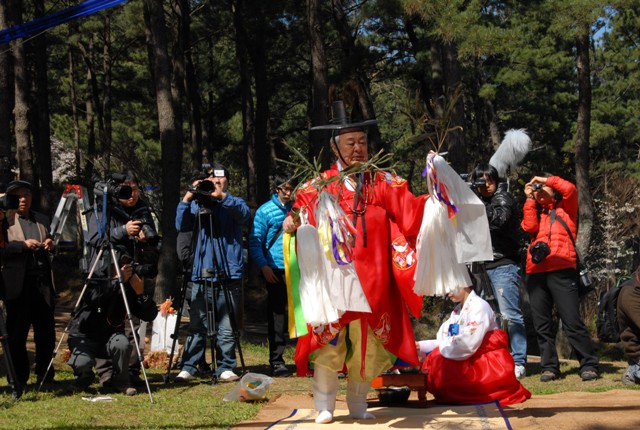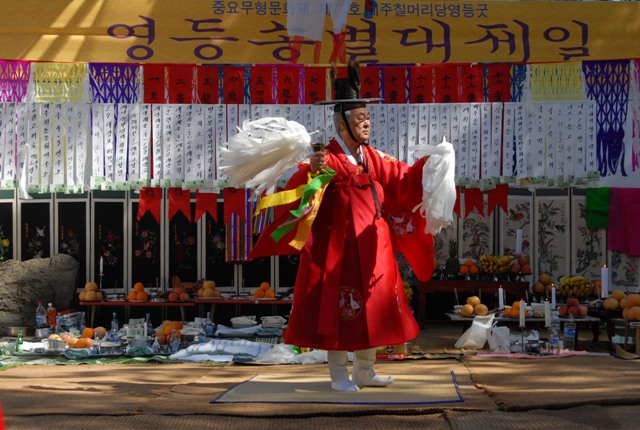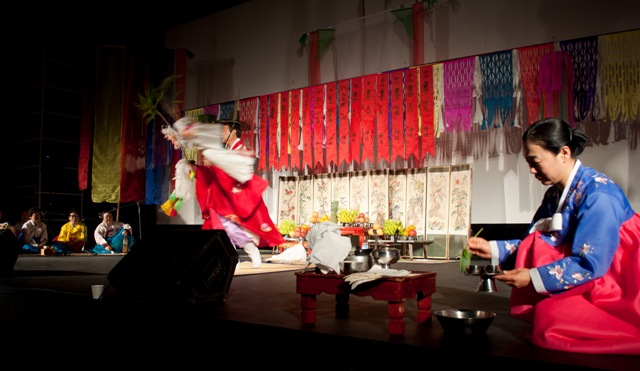| |
 |
|
| ▲ Photo courtesy Darren Southcott |
One way or another, everything came to Jeju by the power of the wind. And just like seasonal westerlies brought the island’s first seeds to its western coasts millennia ago, they also brought cultures which left a memetic imprint still detectable today.
Seed-bearers borne on the wind are prominent in Jeju myth, and it is tempting to imagine a distant folk memory of cultural exchange, trade or even migration.
Tamna’s foundational myth of Samseong tells of maritime winds which bequeathed three divine princesses bearing the seeds of culture for three lonely hunter-gatherers.
The motif is also found in the myths of Yeongdeung Halmang (Yeongdeung Grandmother/Goddess), who descends from Siberia and across the East China Sea to Jeju, seeding both the land and sea.
Yeongdeung and her culture sweep Jeju from west to east and then up the eastern spine of the Korean Peninsula, following the path of the Kuroshio Current and ferocious typhoons.
Fittingly, the goddess is honored most on the Island of Wind, principally during the second lunar month. The month is known on Jeju as the “Month of Yeongdeung”. In some mainland areas she is known as “I-wol Halmeoni” — The Grandmother (Goddess) of February.
While she is a goddess, she is also androgynous and plural; Jeju’s traditions are oral, and each shaman has their own mythological lineage.
Yeongdeung’s key role is in providing bounty and safety to diving women and fishermen as a deity of the wind, sea, fertility, fortune, and much else.
Upon entering at Bukdeokgae in the west, she meanders up and across the island to Mt. Sanbangsan and the 500 Generals rocks on Hallasan. She then leaves in the east at Udo Island.
| |
 |
|
| ▲ Photo courtesy Yang Ho-geun |
Traditionally, her path was marked by two weeks of rituals and revelry. Nowadays, the rites are shorter and held at fewer villages.
The tradition remains, however, and UNESCO added one such village ritual, Chilmeoridang Yeongdeunggut, to its Representative List of the Intangible Cultural Heritage of Humanity in 2009.
Chilmeoridang, on the pictueresque Sarabong Peak, is the village shrine (“dang”) of Chilmeori (now Geonip-dong). The shrine was moved there in the 1970s due to urban sprawl. “Gut” means shamanic ritual, hence Chilmeori-dang Yeongdeung-gut.
The ritual, held this year on March 11, is a crucial thread in the web that weaves together Jeju’s religion and culture, especially that of the “haenyeo” diving women (added to the same UNESCO list in 2016).
To help strengthen this web, the Jeju Chilmeoridang Yeongdeunggut Preservation Society organizes the annual Yeongdeunggut Global Academy. The Academy is headed by Dr. Sunyoung Hong, a local expert in cultural revitalization, with support from the Cultural Heritage Administration and Jeju province.
To make the Academy accessible to an international audience, Dr. Hong also interprets during the workshops, talks, and ritual visits.
As someone fascinated by Jeju shamanism but frankly ignorant of its inner workings, the Academy was invaluable.
It was an inspiration to listen to the wisdom of Grand Shaman (“Keun Shim-bang”) Kim Yoon-su, official skill-holder of the UNESCO-designated ritual, and Shaman Lee Yong-ok.
The talks and craft workshops at Cafe WAVE in Jeju City (March 4, 11, 18 and 25) injected some much-needed realism to my exotic preconceptions of shamanism.
| |
 |
|
| ▲ Photo courtesy Yang Ho-geun |
After answering my questions on the Yeongdeung myth, Shaman Lee jokingly warned that her husband, also a shaman, would probably tell me another version.
Grand Shaman Kim also shared his humility. Coming from a long line of shamans, he had only reluctantly taken up the calling himself after contracting “shin byeong” as a teenager - an affliction associated with shamanism.
There was also a talk by Han Jin-o, a playwright by trade and a scholar by passion. Han’s talk helped put Yeongdeung in a global context alongside other weather deities from India, Greece and China.
Han’s academic precision complemented his personal charm: “Gut is good. Gut is gooood!” he cheerfully proclaimed.
It is a message worth repeating: Practitioners of Jeju shamanism have been persecuted for centuries in Korea.
Shrines were periodically burned down in Joseon Korea (1392-1910), and shamanic beliefs were also suppressed by President Park Chung-hee (1961-79) as barriers to development. Even today, Jeju shrines are routinely vandalized by religious zealots and developers.
Locals are steeped in this history, and that is why it is so important to celebrate the traditions alongside the aging devotees (“dangol”) before the traditions fade.
Although the “dangol” were mostly elderly at the rituals, we were far from the only young family in attendance.
My daughter is 3.5 years old, and it will be left to her generation to reimagine Yeongdeung’s future. I took her along to the rituals and craft workshops so she could experience this heritage.
| |
 |
|
| ▲ Photo courtesy Yang Ho-geun |
What she enjoyed most was making colorful “gime” paper. At rituals, “gime” hangs from holy trees (and tents nowadays), swishing in the wind as symbolic holy representations.
It was heartening to see the children enjoy the rituals just as many elderly Jeju people say they did as youngsters.
This was most obvious for me at Gwideok. Although the ritual was being held under white Mongolian -style tents rather than at the village shrine (“bonhyangdang”), half of the village turned out, and they were intent on celebrating.
No one could remember the last time a Yeongdeunggut ritual had been held in the village, and they were making up for lost time.
While the shaman called out to the Goddess, the haenyeo diving women sat nearby, ensuring their wishes were heard.
As the drumming intensified, I wandered to the rear of the tent where I found three spinning grandmothers, arms aloft and giddy with teenage laughter. Their eyes were wrinkled up in sheer joy and smiles flashed across their faces.
The decades had rolled back, and they were in their youth. For a brief moment, the intangible was made tangible, and Youngdeung’s bountiful harvest was clear to see.
To learn more about Yeongdeunggut Global Academy please contact Dr. Sunyoung Hong at syhong0216@gmail.com. |























